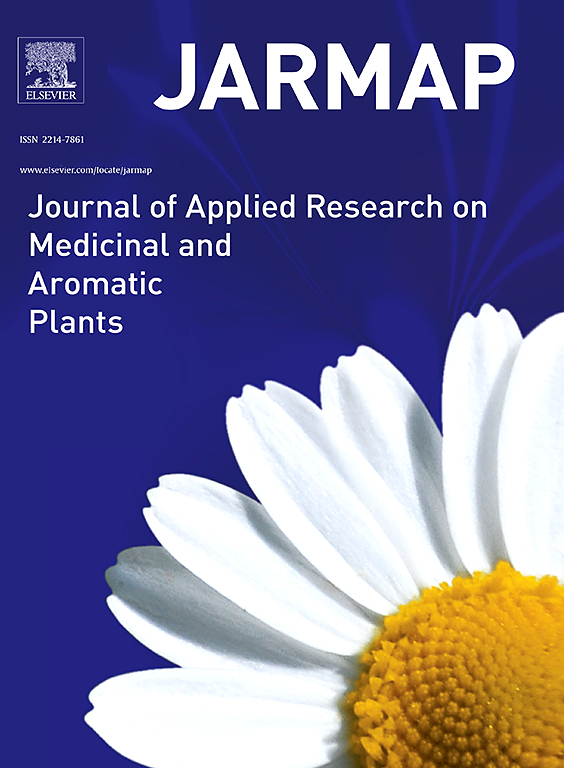Microsatellite marker resource creation, genetic diversity assessment and core prediction in Valeriana jatamansi Jones
IF 3.6
2区 农林科学
Q1 PLANT SCIENCES
Journal of Applied Research on Medicinal and Aromatic Plants
Pub Date : 2024-12-26
DOI:10.1016/j.jarmap.2024.100616
引用次数: 0
Abstract
Valeriana jatamansi Jones, a potential ethno-medicinal herb of global importance faced an unprecedented threat of its habitat loss due to burgeoning global demand. Genome-wide microsatellites or simple sequence repeats (SSRs) marker resources are advantageous, unfortunately, such larger resources have not been explored for genetic improvement in V. jatamansi. In the present study, transcriptome-derived functionally relevant microsatellite marker resources comprising 7957 SSR markers with significant homology (66.3 %) with public functional databases were created. Interestingly, 103 putative functional SSR markers derived from unigenes exhibited substantial annotations with secondary metabolite biosynthesis, transcription factors, and transporters were synthesized and experimentally validated in diverse genotypes. SSR loci with good marker attributes (average alleles/ locus: 7.5; PIC: 0.44; resolving power: 5.25) were successfully utilized for genetic population structure analysis of 525 genotypes representing 29 geographically diverse populations. Despite representing three genetic populations, north-western Indian Himalayan regions (wIHR) exhibited with low genetic diversity (h: 0.22) with moderate gene flow (Nm: 0.97) and high molecular variance (71 %) within population. Moreover, the predicted core of 53 genotypes representing 21 diverse populations was validated successfully using NJ clustering and regression correlation (R2 > 0.85). Additionally, future habitat suitability is predicted to decline in at least 49.89 % habitat area of V. jatamansi. Hence, climatic zones with improved suitability can be potential geographical areas for its conservation and sustainable cultivation. The current findings including huge molecular markers resources, diversity inferences, and identification of core collections will facilitate gene bank management, selection of potential parental groups/ cultivars for implementation of molecular breeding strategies, genetic improvement, and sustainable cultivations of V. jatamansi for industrial utilization.
芥蓝微卫星标记资源创建、遗传多样性评价及核心预测
由于全球需求的迅速增长,具有全球重要意义的潜在民族药材缬草面临着前所未有的栖息地丧失威胁。全基因组微卫星或简单序列重复(SSRs)标记资源是有利的,不幸的是,这种更大的资源尚未被开发用于贾塔马西的遗传改良。本研究共构建了7957个与公共功能数据库具有显著同源性(66.3% %)的转录组衍生功能相关微卫星标记资源。有趣的是,从不同基因型中合成并实验验证了103个假设的功能SSR标记,这些标记显示了大量的次级代谢物生物合成、转录因子和转运蛋白。具有良好标记属性的SSR位点(平均等位基因数/位点:7.5;图片:0.44;分辨率为5.25),对29个不同地理种群的525个基因型进行了遗传群体结构分析。西北印度喜马拉雅地区(wIHR)虽然代表了三个遗传群体,但群体内遗传多样性低(h: 0.22),基因流适中(Nm: 0.97),分子变异高(71 %)。利用NJ聚类和回归相关(R2 >;0.85)。未来生境适宜性至少会在49.89 %的生境面积上下降。因此,适宜性较好的气候带可作为其保护和可持续栽培的潜在地理区域。目前的研究成果包括丰富的分子标记资源、多样性推断和核心种质的鉴定等,这些成果将为植物基因库的管理、潜在亲本群体/品种的选择和分子育种策略的实施、遗传改良以及产业化利用的可持续栽培提供依据。
本文章由计算机程序翻译,如有差异,请以英文原文为准。
求助全文
约1分钟内获得全文
求助全文
来源期刊

Journal of Applied Research on Medicinal and Aromatic Plants
Pharmacology, Toxicology and Pharmaceutics-Drug Discovery
CiteScore
6.40
自引率
7.70%
发文量
80
审稿时长
41 days
期刊介绍:
JARMAP is a peer reviewed and multidisciplinary communication platform, covering all aspects of the raw material supply chain of medicinal and aromatic plants. JARMAP aims to improve production of tailor made commodities by addressing the various requirements of manufacturers of herbal medicines, herbal teas, seasoning herbs, food and feed supplements and cosmetics. JARMAP covers research on genetic resources, breeding, wild-collection, domestication, propagation, cultivation, phytopathology and plant protection, mechanization, conservation, processing, quality assurance, analytics and economics. JARMAP publishes reviews, original research articles and short communications related to research.
 求助内容:
求助内容: 应助结果提醒方式:
应助结果提醒方式:


